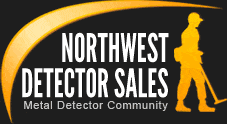
How to Pinpoint With Minelab Equinox Coils and Other Detectors!
Although my video that’s linked to this article about pinpointing with metal detectors specifically uses the Minelab Equinox 800 with the 15” inch coil, this technique can also be used for pinpointing with any metal detector--especially when using large coils.

Small coils (5-6” inches) are easy to pinpoint with. Medium coils (9-11” inches) are also not difficult to get the hang of, but can be tricky depending on the detector and how it was programmed.
Large coils however, 12” inches and over, start to become a headache. In the case of the Equinox, you are trying to pin-point a dime-size object in the center of a 15” inch coil. If you are digging in a public area and you don’t want to leave massive ugly craters as you mosey along, you’re going to want to be confident you can pinpoint that dime within a 3” inch circle for a small clean plug.
Not all coils are alike, and they do not pinpoint exactly on center. I have watched many videos of experienced metal detecting professionals getting frustrated with their first run with a large coil. In fact, I ran into a guy who said he doesn’t even use the 15” inch coil he bought for his Equinox because “it’s too hard to pinpoint with”, and he wasn’t a spring chicken!

The Pinpointing Cure
When I first began experimenting with this technique I would pinpoint my target, then turn 90-degrees and pinpoint again, forming a crosshair over my target's exact location. However, soon I realized that using the pinpoint button was a waste of time entirely.
As you will see in the Youtube video, when I find a good signal I begin a very small, tight, medium speed wiggle over it. As I perform this tight sweep/wiggle, I move the coil forward and back listening for the target's signal strength, and where it drops off.
Once I find the signal strength, I keep the center of the coil directly over that spot, and turn 90-degrees. After turning 90-degrees I perform the same tight sweep/wiggle to find the signals strength on that axis.
Again, what you’re going for is centering your target in an imaginary crosshair. When you turn 90-degrees, more often than not you will find you have to move your coil a few inches right or left to get the target centered. This is because the coil does not pinpoint exactly on center. So don’t be deterred if you turn 90-degrees and have to move the coil a little to find the target signal again!

Pinpointing and Recovery of the Target
Now that you have formed your imaginary crosshair over your target, you kneel down to recover it, and you turn your head away to look for your digging tool. When you look back down at the grass you’ve already forgotten the exact location of the center of your crosshair!
So, to properly avoid this headache, what I do is I visualize my crosshair while I turn 90-degrees and wiggle, and I repeat that until I feel confident I know the exact center of the target. I keep my eyes laser focused on that spot and kneel placing my finger directly on that spot in case my eyes wander or I get distracted (you can also use the tip of your boot). With my other hand I reach back and grab my digging tool and we’re off to the races!
Make sure to grab your handheld pinpointer too, and do a sweep over the surface of the soil first (keep your eyes or finger on your crosshair at all times!!). This will save you a huge amount of time for tiny surface targets or surface coins that can be recovered quickly without having to dig larger plugs.

This pinpointing technique works 99.99999999% percent of the time for me. In fact, it works better than any metal detector pinpointer that I’ve ever owned, I just wish I had discovered it sooner!
Many metal detectors will pinpoint off on coins on edge and nails, this technique works great on those too! I have not yet had to dig some massive crater only to find a nail. All objects have been pretty much directly on my crosshair if not slightly off but still in the hole, and if for some reason they weren’t--it was because my technique was sloppy and I didn’t refine my crosshair enough.
So the bottom line is, get your target location honed down to a tight spot, do as many 90-degree turns as you’d like until you’re confident, (it usually only takes me two or three), and I guarantee you will save time and energy by recovering targets more easily with massive coils!

